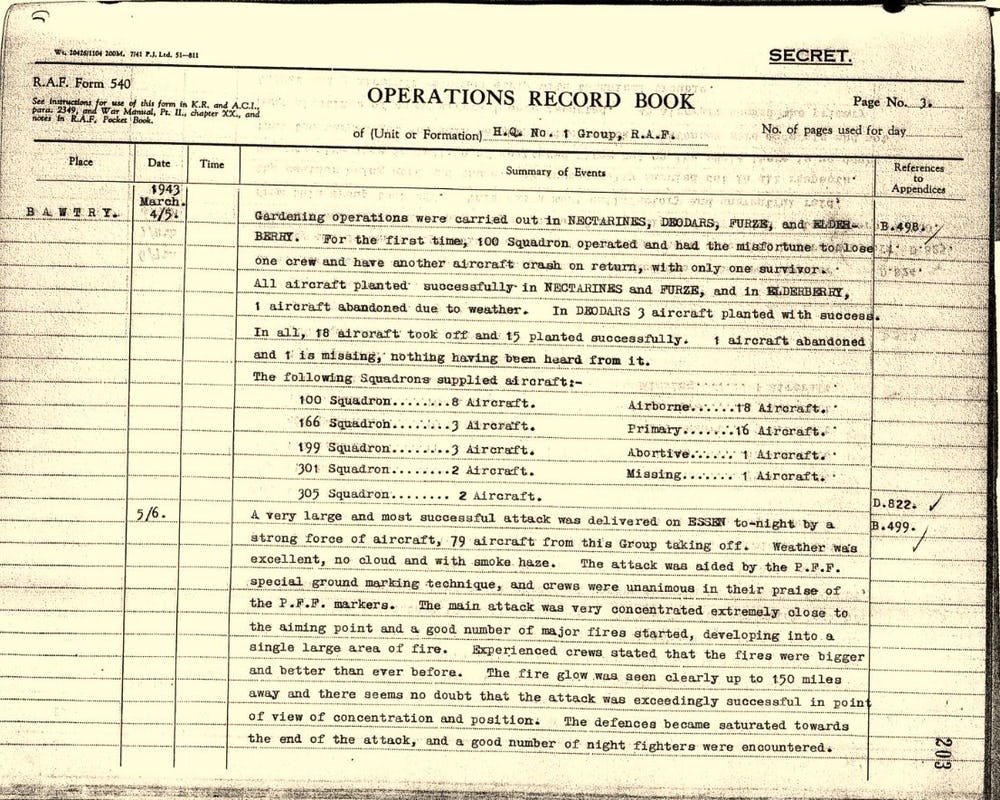Remembering the crew of Lancaster ED559
"One aircraft failed to return". That's how I've often read of the loss of ED559 (and of hundreds of other aircraft). Five simple words that tell almost next to nothing of the lives of seven young men lost during the Second World War.
It's hard to understand the inner strength that each man found to climb into their 'kites' each night. Reading the biographies of airmen like Don Charlwood ('No Moon Tonight') and Miles Tripp ('The Eighth Passenger') it's amazing to read how crews dealt with the loss of friends and found the courage to climb back into their bombers to undertake another operation.
A certain fatalism is present but also the feeling that someone else will get the 'chop'. After all these years it amazes me how relative strangers quickly bonded to form an esprit de corps that would see them take off into the night together.
Though I never knew these men, I do recognise their sacrifice and with humble thanks dedicate these pages to their memory.
It's hard to understand the inner strength that each man found to climb into their 'kites' each night. Reading the biographies of airmen like Don Charlwood ('No Moon Tonight') and Miles Tripp ('The Eighth Passenger') it's amazing to read how crews dealt with the loss of friends and found the courage to climb back into their bombers to undertake another operation.
A certain fatalism is present but also the feeling that someone else will get the 'chop'. After all these years it amazes me how relative strangers quickly bonded to form an esprit de corps that would see them take off into the night together.
Though I never knew these men, I do recognise their sacrifice and with humble thanks dedicate these pages to their memory.
"...1 is missing, nothing having been heard from it..."
The fate of ED559 as recorded in the Operations Record Book for HQ No.1 Group, RAF Bawtry, March 1943.
The human cost of the bombing offensive against Germany
The commemoration board at the former RAF Station Waltham displays the cost:
Over 1,000 brave young men came through this entrance - never to return.
Many more were shot down and captured.
We will remember them and salute all who served here.
Every single person who flew with Bomber Command was a volunteer.
During the Second World War 55,573 aircrew were killed. 28% of those casualties came from outside the UK (a lot drawn from the former Dominions of Australia, Canada, New Zealand and South Africa as well as from many occupied countries - Poles, Norwegians etc.).
A Lancaster and its crew were only expected to survive on ops for just three weeks.
During the Second World War 55,573 aircrew were killed. 28% of those casualties came from outside the UK (a lot drawn from the former Dominions of Australia, Canada, New Zealand and South Africa as well as from many occupied countries - Poles, Norwegians etc.).
A Lancaster and its crew were only expected to survive on ops for just three weeks.
For every 100 airmen, this was their fate:
- 55 killed on operations or died of wounds
- 3 injured
- 12 became Prisoners of War (PoWs)
- 2 shot down and evaded capture
- 27 survived a tour of 30 operations
Total RAF Bomber Command casualties during WW2
In May 1947, the Air Ministry released the following:
Killed in action or died while prisoners of war 47,268
Killed in flying or ground accidents 8,195
Killed in ground-battle action 37
Total fatal casualties to aircrew 55,500
Prisoners of war, including many wounded 9,838
Wounded in aircraft which returned from operations 4,200
Wounded in flying or ground accidents in U. K. 4,203
Total wounded, other than prisoners of war 8,403
Total aircrew casualties 73,741
Killed in action or died while prisoners of war 47,268
Killed in flying or ground accidents 8,195
Killed in ground-battle action 37
Total fatal casualties to aircrew 55,500
Prisoners of war, including many wounded 9,838
Wounded in aircraft which returned from operations 4,200
Wounded in flying or ground accidents in U. K. 4,203
Total wounded, other than prisoners of war 8,403
Total aircrew casualties 73,741
Total Bomber Command aircraft losses during WW2
364,514 operational sorties flown between 1939-45.
3,491 aircraft were lost flying from Lincolnshire.
It cost £10,000 to train crew (equivalent of £400,000 today)
An operational sortie cost approximately £100,000.
3,491 aircraft were lost flying from Lincolnshire.
It cost £10,000 to train crew (equivalent of £400,000 today)
An operational sortie cost approximately £100,000.
Lincolnshire - Bomber County
RAF Grimsby - known to all who served there at Waltham - was located in the northeast of Lincolnshire. This county was later to be known as Bomber County due to the high number of airfields situated within it.
25,611 aircrew were killed flying from Lincolnshire or 46% of the total of all aircrew lost.
There were 46 airfields (covering 30,000 acres) during the peak of wartime activity with approximately 80,000 RAF personnel and 1,000 aircraft.
There were 16 airfields within a 10 mile radius of Lincoln.
Northern half of the county fell into 1 Group and this group lost 1,429 aircraft and 8,577 aircrew in total.
25,611 aircrew were killed flying from Lincolnshire or 46% of the total of all aircrew lost.
There were 46 airfields (covering 30,000 acres) during the peak of wartime activity with approximately 80,000 RAF personnel and 1,000 aircraft.
There were 16 airfields within a 10 mile radius of Lincoln.
Northern half of the county fell into 1 Group and this group lost 1,429 aircraft and 8,577 aircrew in total.



